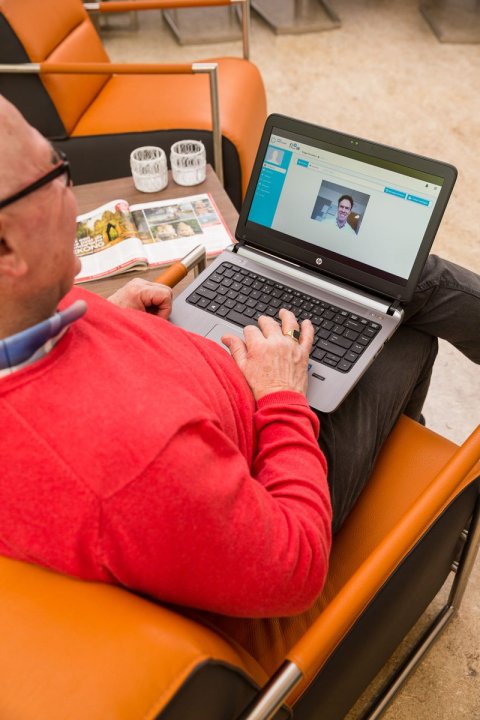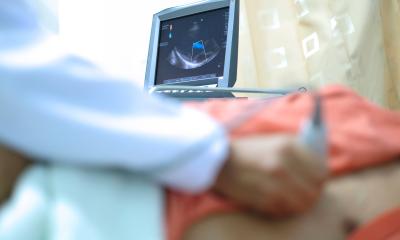News • Cardiac care
Exploring the potential of tele-rehabilitation
During the corona pandemic, many doctors were forced to provide care remotely and digitally. For heart patients, however, this could be good news, according to PhD research at Eindhoven University of Technology.

Image source: Eindhoven University of Technology; photo: Máxima Medical Center
Following a cardiac rehabilitation program – which is vital after a heart attack or a sudden angioplasty – can be done just as well at home as in the hospital. This is the conclusion of PhD student Rutger Brouwers from the most extensive research into ‘telerehabilitation’ to date. Time to implement this form of e-health on a large scale, says Brouwers.
Participation in cardiac rehabilitation in patients with coronary artery disease reduces their burden of disease and risk of death, improves their quality of life and reduces healthcare costs. Usually, the exercise program of the cardiac rehabilitation program takes place at the physical therapy department in the hospital. For patients, that means visiting the hospital twice a week for almost three months for training under the supervision of a physical therapist. “We see that this is too big a barrier for many patients, with the result that less than half of the patients participate in regular cardiac rehabilitation in the hospital,” says Rutger Brouwers, physician-researcher at the Máxima Medical Center (MMC) in Eindhoven and TU/e researcher in the Future Everyday research group at the Faculty of Industrial Design.

Image source: Eindhoven University of Technology; photo: Máxima Medical Center
The risk of relapse is also high. “Patients unfortunately often fall back into their old lifestyle pattern after intensive counseling, while we know that improving lifestyle greatly reduces the risk of incident or recurrent heart disease. Therefore, there is an urgent need for innovative rehabilitation methods that ensure that more patients participate and fewer patients relapse."
In collaboration with MMC, Brouwers evaluated such an innovative rehabilitation method, which you can simply follow from the comfort of your own home. "This involves the use of wearable sensors (such as a heart rate monitor) and communication via telephone or video calls." This so-called telerehabilitation has several advantages for patients: less travel time, fewer hospital visits, direct access to their data and progress and thus control over their treatment.
But for some time now, the question has been: which treatment is better? Hospital-based rehabilitation or telerehabilitation? Based on research among 300 heart patients in the SmartCare-CAD study – the largest cardiac telerehabilitation study to date – it now appears that both methods work equally well for the patients who were trained at home as for the patients in the hospital: after one year they are physically more active, have better exercise capacities, experience a higher quality of life, are less depressed and can cope better with their condition in their daily lives. He therefore advocates that telerehabilitation be applied on a much larger scale with cardiac patients. "We've been talking for years about how e-health can improve healthcare and reduce healthcare costs," says Brouwers, "but so far hospitals have been very reluctant to work with it. It's time we started using it on a large scale. It can be done and it has to be done!"
Brouwers, who in addition to being a researcher is also a cardiologist-in-training at the Catharina Hospital, developed a new telerehabilitation program especially for his research, in which the regular three-month treatment was extended by nine months to minimize the risk of relapse. Randomization determined which of the two treatments a participant received. Half of the study participants attended standard cardiac rehabilitation in the hospital for three months. The other half first attended six training sessions in the hospital, supervised by a physical therapist. Then the participants trained themselves at home for three months with wearable sensors, during which they were guided remotely. Afterwards, they were monitored remotely for another nine months. After one year, the two treatments were compared.
What was striking, was that a relapse in daily physical activity or exercise training was rarely seen in the study. Brouwers attributes this to the fact that, similar to other studies on cardiac telerehabilitation, relatively many young men with a low risk of recurrent heart problems participated. "For future research, it's important to find out how we can also motivate other patient groups, who are more likely to relapse into less healthy behaviour, to utilise telerehabilitation." He is thinking particularly of people with more severe heart problems, elderly patients and patients with lower educational levels.
Source: Eindhoven University of Technology
15.02.2022











